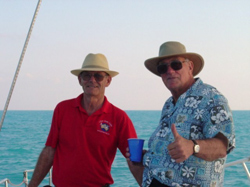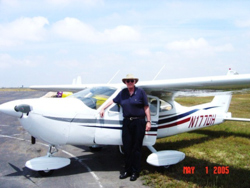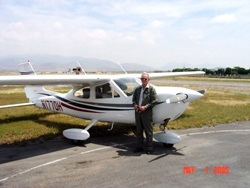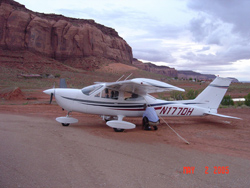 At 71, Jim Chapman (left) and George Futas set out on one of their most ambitious flying adventures: a flight to the four corners of the United States. Seen here in Key West, Fla.
At 71, Jim Chapman (left) and George Futas set out on one of their most ambitious flying adventures: a flight to the four corners of the United States. Seen here in Key West, Fla.
After a hiatus of nearly seven decades, Lt. Col. Maury Marler is back at the controls as pilot in command.
Marler, 91, first earned his pilot certificate in 1941 through the Civilian Pilot Training Program and flew for only a year before giving up flying to serve as a navigator in the Army Air Corps. He made a career in the navigator’s seat but didn’t start to yearn for the controls again until he moved to a retirement community in Renton, Wash., and heard the buzzing of small airplanes from the nearby airport.
“I just got an uncontrollable urge to start flying again,” Marler said. After checking one flight school that wanted nothing to do with the then-90-year-old pilot because of his age, he found an instructor who encouraged him to train for a private pilot certificate. Marler’s pilot certificate from the Civil Aeronautics Authority had become invalid because he did not convert it to an FAA certificate.
Marler has been flying for a year now with instructor Len Quiat. His flight training has garnered attention from the local news station and even led to a lively appearance on The Bonnie Hunt Show this spring, just before his ninety-first birthday. According to Quiat, news of a 91-year-old student pilot elicits strong feelings from people—some disapprove of a man that age flying, while others are inspired to try flying themselves.
 The keys to Marler’s flight training, Quiat said, are patience and realism. Marler is in good health and has passed his medical but is in no hurry to solo; older student pilots generally take longer with flight training. Not every 91-year-old should take the controls of an airplane, but Quiat said Marler’s good health, mental acuity, and excitement make him seem at least 20 years younger.
The keys to Marler’s flight training, Quiat said, are patience and realism. Marler is in good health and has passed his medical but is in no hurry to solo; older student pilots generally take longer with flight training. Not every 91-year-old should take the controls of an airplane, but Quiat said Marler’s good health, mental acuity, and excitement make him seem at least 20 years younger.
So how old is too old to fly? The effects of aging on pilot performance are not entirely clear, but age in itself should not discourage someone from flying; genetics, lifestyle, and experience all contribute to one’s “true age.”
The AOPA Air Safety Foundation is currently conducting research on the effects of aging on pilot performance, working with the University of North Dakota. “Age will ultimately affect most of us in some fashion. Individually, we just don’t when or how,” said Bruce Landsberg, president of the foundation. “This research will give us some objective benchmarks to help pilots determine when it may be time to throttle back a bit or perhaps to start flying with someone else as PIC. “
Thousands of American pilots over the age of 70 know that a few extra candles on your birthday cake don’t have to keep you from the cockpit. Pilots can fly well into their golden years, or even take up flying late in life. When it comes to flying it’s attitude and aptitude, not age, that matter.
“Both the medical and actual flight instruction are demonstrated-ability situations: If you can pass the tests, you're in. If you can't, you're out, and that applies across the board regardless of age,” Budd Davisson writes in a December 2002 AOPA Flight Training feature listed in the Pilot Information Center Subject Report: Older Students, Never Too Old.
 The challenges each student pilot faces are unique to the person and depend not just on age but on attitude, life experiences, and learning styles; but people learning to fly or brushing up on their skills late in life tend to have many of the same concerns. Will my health disqualify me? Will I be able to adjust to new airspace restrictions? Can you really “teach an old dog new tricks”? For many, flying may be more attainable than they think—and flying later in life can lead to adventures that may not have been feasible for a younger pilot with family responsibilities and a full-time job.
The challenges each student pilot faces are unique to the person and depend not just on age but on attitude, life experiences, and learning styles; but people learning to fly or brushing up on their skills late in life tend to have many of the same concerns. Will my health disqualify me? Will I be able to adjust to new airspace restrictions? Can you really “teach an old dog new tricks”? For many, flying may be more attainable than they think—and flying later in life can lead to adventures that may not have been feasible for a younger pilot with family responsibilities and a full-time job.
According to the most recent data from the FAA, more than 27,000 active pilot certificates were held by people age 70 and over at the end of 2007, although not all of those pilots still fly. Those pilots have to have a current medical certificate in order to keep flying. (For private pilots, the FAA starts requiring medical certification more often—every two years—once a pilot reaches age 40.) It may take longer for pilots with medical issues to be approved, but that doesn’t mean it can’t be done.
“As we age, we’re just going to have more medical challenges,” said Gary Crump, director of medical certification at AOPA’s Pilot Information Center. “But having a problem such as heart disease, diabetes, or cancer in your medical history does not have to be a deterrent to getting your pilot certificate. These are all surmountable problems.” But there may be some significant cost in jumping through all of the FAA-required hoops.
“There are a lot of people who think they have to meet ‘astronaut standards’” to get a medical certificate, he said. “That’s just not the case.”
He said improvements in medical treatment and the risk assessment processes of the FAA allow pilots to get a certificate with a medical condition that may have been disqualifyingr 15 years ago—as long is the pilot is prepared to work through the bureaucratic paperwork process to prove to the FAA that the condition is not a risk in flight.
 Losing a medical is not necessarily final, either. Jim Chapman, 74, took a break from flying at the direction of the FAA a few years ago when he lost sight in one eye. He lost his medical, but with the help of AOPA’s Pilot Information Center, he got it back after three years of proving to the FAA that he was capable.
Losing a medical is not necessarily final, either. Jim Chapman, 74, took a break from flying at the direction of the FAA a few years ago when he lost sight in one eye. He lost his medical, but with the help of AOPA’s Pilot Information Center, he got it back after three years of proving to the FAA that he was capable.
“It took a lot of time and effort, and they gave me a very, very thorough flight test, but it was fair,” he said.
Chapman and his friend George Futas, also 74, have taken advantage of their “golden years” to fly on some of their longest trips together: The second of two 5,000-mile trips through Australia was in celebration of their seventieth birthdays. The following year, the two men went on their longest trip together yet: a 25-day, 10,000-mile trip from coast to coast and back in Chapman’s Cessna 177 Cardinal.
“I still get great pleasure out of flying—I like what I see,” Futas said. “It’s a different view of the world. You see these mountains and deserts from altitude. … The sights still give me a thrill.”
The men saw plenty of sights on their trip to the farthest corners of the country, what they call their “Four Corners” trip. They left from Brown Field in San Diego, Calif., on May 1, 2005, with charts and a few points of interest in mind, but no fixed itinerary. The trip took them across the continental United States; up the East Coast from Key West, Fla., to Eastport, Maine; back across through part of Canada to Blaine, Wash.; and down the coast again to San Diego. Along the way, they stopped at small airports, air museums, and other places of interest, including the striking landscape of Monument Valley, immortalized in the Westerns of John Ford, and the Hudson River VFR corridor on the west side of Manhattan. They returned to San Diego May 26.
 Futas said he and Chapman would not have had the flexibility to go on a trip like their four corners flight earlier in life, when job demands and family responsibilities meant trips had to be shorter and more structured. He said he now has more free time and a little more money to put toward his passion for flying.
Futas said he and Chapman would not have had the flexibility to go on a trip like their four corners flight earlier in life, when job demands and family responsibilities meant trips had to be shorter and more structured. He said he now has more free time and a little more money to put toward his passion for flying.
To embark on the adventure, Chapman first had to overcome another of the obstacles many pilots face upon returning to flying: airspace regulations. He said he got his private pilot certificate in about 1970 and later got his instrument rating—in fact, he was Futas’s first instrument student—before taking a two-decade break from flying. He said he had been busy running a business and decided to stop when new airspace restrictions made it a hassle. “Things just got too complicated,” he said. “It wasn’t the flying, it was the rules.”
Those rules were Chapman’s primary concern when he decided to take up flying again in the mid-1990s. But he said he came up to speed quickly after doing some research and flying with an instructor to brush up on his skills and knowledge. “It’s worth it,” he said.
Catching up with new regulations can be intimidating, but “ AOPA’s Pilots’ Guide to Getting Back into Flying” can guide you through the changes and help you get back into the air. The AOPA Air Safety Foundation’s free seminars and more than 30 online courses and quizzes will be extremely helpful. Mastering the legal aspects of flying may in fact be the hardest part: The fundamentals of flying have not changed. Habit patterns are deeply ingrained by repetition, and much of flying is repetitive or variations on a theme.
Lessons earlier in life may serve you well: The National Transportation Safety Board (NTSB) has noted that pilots who learned to fly when they were young generally do better than those who waited until late in life. However, you don’t have to give up the dream of flying if you don’t already have training under your belt. Just be prepared for it to take a while.
 Futas, who trained Chapman for his instrument rating nearly 40 years ago, has had students of all different ages and is still providing flight instruction. He said younger students tend to pick up new ideas and tasks that require hand-eye coordination quickly, while older students may have trouble with multitasking or the new technology in glass cockpits. He stressed, however, that a person’s individual experience can have a significant effect on the student’s learning process. Someone used to doing tasks serially at work may take longer to adjust to doing several things at once, for instance.
Futas, who trained Chapman for his instrument rating nearly 40 years ago, has had students of all different ages and is still providing flight instruction. He said younger students tend to pick up new ideas and tasks that require hand-eye coordination quickly, while older students may have trouble with multitasking or the new technology in glass cockpits. He stressed, however, that a person’s individual experience can have a significant effect on the student’s learning process. Someone used to doing tasks serially at work may take longer to adjust to doing several things at once, for instance.
Young or old, students must be willing to put in extra work for those tasks that give them trouble. That may mean practicing a lot more landings—and it will probably mean a healthy dose of humility.
“It starts with attitude, no matter what their age is,” Futas said. He said the hardest students to teach are those who think they already know everything. For older students who bristle at the idea of taking direction from some 20-something flight instructor, Futas sometimes steps in. “Sometimes it takes an older guy to talk to an older guy,” he said.
Many instructors have found that older students can be their best students. The same principles apply for pilots across the board. Ultimately, much of safe flying comes down to that ancient aphorism: Know thyself.
 “Maintain good physical and mental condition. Seek out the best instruction you can afford,” said Landsberg. Older pilots should “approach new situations with caution. Confidence tends to decline more slowly than skill,” he said.
“Maintain good physical and mental condition. Seek out the best instruction you can afford,” said Landsberg. Older pilots should “approach new situations with caution. Confidence tends to decline more slowly than skill,” he said.
At his home airport in Washington State, Marler continues his flight training with the same undying enthusiasm. He and Quiat have made some accommodations for Marler’s physical limitations—including using a ladder to reach the fuel tanks during preflight and using a Cessna 172 rather than a Diamond DA20, which was less accessible for Marler. They started out with shorter sessions that were easier for Marler to process and are not afraid to cut a flight short if it stops being fun.
Marler said he flies now with a greater appreciation of the experience than when he was young. “Sure, it was a thrill then, it was a lot of fun then,” he said. But now every time he experiences the thrill of controlling the airplane and flying above the earth, he thanks his creator for the opportunity, he said. Even if he never qualifies for a pilot certificate, he said, he intends to keep flying with an instructor because he enjoys it so much.
And he has some advice for other pilots and aspiring pilots in their golden years: “If you can afford it, and if you have fun, do it. But if you’re not having fun, don’t do it. Give it your best shot while you can. Just because you’re old doesn’t mean you have to be old.”


